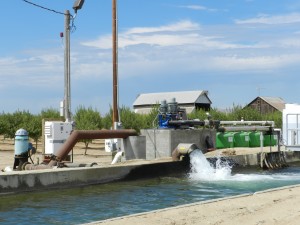
Despite state-mandated regulation, vast stores of groundwater have disappeared from the Colorado River Basin and the Ogallala Aquifer. The water is gone for a simple reason: More has been taken out than has come in.
The simple notion of overdrafting—taking more from an account than has been put in— is something people learn early on when it comes to checking accounts. “Money in minus money out” is the basis for our universal exchange system. Unfortunately, groundwater is exempt from the rule.
Even though California imposed groundwater regulation last year, it’s highly probable we will deplete our aquifers beyond recovery. A good case in point is the Stanislaus County Groundwater Ordinance, which superficially looks like a pro-active response to overdrafting groundwater.
Unfortunately, the Ordinance fails under scrutiny. The biggest problem is exemptions. Water districts and “public water agencies” are exempt from restrictions imposed by the ordinance.”
Two water districts within the county are especially noteworthy for pumping groundwater. In one, the East Side Water District, groundwater is the sole source for thousands of acres of irrigated agriculture, mostly vineyards and nut orchards. The other district, the Oakdale Irrigation District, pumped a record amount of groundwater last year, despite having some of the best surface water rights and sources in the state.
The other problem is with cities. Most cities in the San Joaquin Valley are dependent on groundwater for their residential and urban needs. Modesto is one of the few with ample supplies of surface water, but even Modesto had to pump more groundwater this year, when the drought reduced supplies of surface water.
Even at the point when everyone’s lawn has turned brown, the swimming pools are empty, and the daily shower has become a memory, people will still need water. That means pumping for cities will continue.
The Stanislaus County Groundwater Ordinance targets unincorporated parts of the county. The focus is on the county’s east side, where tens of thousands of acres of almond orchards have been planted over the last decade. While there’s no question eastern Stanislaus County is in dire need of groundwater regulation, targeting specific areas for regulation ignores some fundamental facts about groundwater.
Probably the most important problem is that the aquifer system is inter-connected. Some Stanislaus County officials and members of the Stanislaus County Water Advisory Committee have maintained publicly that pumping from one aquifer doesn’t necessarily affect another. According to Dr. Vance Kennedy, that notion is erroneous. Kennedy is an award-winning hydrologist, retired from the United States Geological Survey.
Kennedy has long maintained pumping from one aquifer almost always affects other aquifers, though the effect may not be immediately evident. The Modesto Bee published Kennedy’s explanation of the inter-connected relationships among aquifers on May 9.
Unless Kennedy is grossly wrong, exemptions from regulation of groundwater use will not make pumping groundwater sustainable, they will ensure it’s depleted. Pumping in the exempt areas will draw from adjacent areas.
Dr. Kennedy is most likely right. Absent “water-in minus water out” accounting on a regional basis, regulation of groundwater can only fail. So far, neither state nor local authorities are willing to balance the books. Look for more failed aquifers and all the attendant problems.

Curious if other renowned hydrologists have weighed in on the acquirer, separate vs. interconnected discussion.
Seems like with today’s technologies we would know one way or other.
Agreed. I have asked some of the people making the claims about separate aquifers what their sources are. There have been no replies. Also no response to Dr. Kennedy’s Bee article. Incidentally, Dr. Kennedy checks with other professionals before he submits things for publication. He is a careful man.